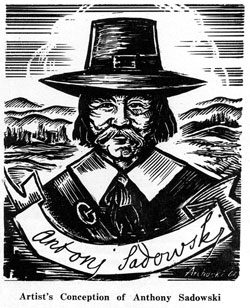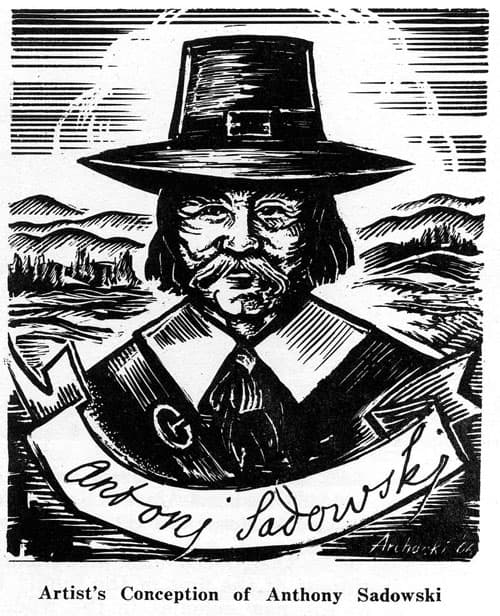
The stub in Wikipedia on the origin of the name is phony. The article in Polish by Wojciech A. Wierzewski, the late editor of Zgoda, “The Turbulent Life of Antoni Sadowski,” in Gazeta Polska, October 7-8, 2006, is closer to the truth.

For years, the descendants of the Polish frontiersman, who changed their last name to Sandusky in the 1750s, and a host of supporters were belittled and, worse, ignored for their knowledge of Sandusky, Ohio. I barely scratched the surface in my work, Anthony Sadowski:Polish Pioneer, which is now on < www.Poles.org>.
The first white settlers of Sandusky, Ohio, without an investigation of the traders who criss-crossed over their land to trade with Indians, mistakenly assumed that the place name came from an Indian word.
THE BEGINNING
Probably nobody before the name of Sandusky, or its variants, was marked on a map knew more about the nameless spot on the shores of Lake Erie than Michael Bizaillion, for in 1718 he drew a map to show the routes of fur traders from Canada to the Mississippi River, which was as much as anyone knew of the Indian trade at the time.
Among the fur traders James Logan dealt with were Peter Bizaillion, who came from Auverque, France, and Anthony Sadowski, whom Logan called “the Polander of Manatawny.” Fur traders were licensed by law in Pennsylvania, and instead of buying one, it looked like Sadowski would buy and sell for Bizaillion as well as work for him until 1718.
As is well known, Antoine Cadillac set out from Montreal with 100 men and three months’ provisions to establish a French post on the strait between Lake Erie and Lake Huron on July 23, 1701, for the purpose of keeping Logan’s dealers from trading with Indians. Despite Cadillac’s efforts, Michael Bizaillion, who worked for Peter Bizaillion, set up a depot in what is now Detroit to trade with Indians in French territory.
Whether they were there at the same time, I found records of the two Frenchmen and the Polish frontiersman in Philadelphia, where Logan stored English goods in a warehouse and shipped furs to England.
BIZAILLON FAMILY
Peter Bizaillion, either alone or secretly in partnership with his brother, Sadowski, other indiduals, had for years wandered and traded with the Indians. As early as 1705, in the account books of James Logan, who got rich in the fur trade, one finds that Peter Bizaillion, who had a license in Pennsylvania to trade with the Indians since the 1690s, bought furs and skins from Indians, wherever he found them in the far wilderness, and had his men transport them in horse-drawn wagons to Logan’s warehouse in Philadelphia and return to Bizaillion’s diggings with manufactured goods from England. In 1707, when Logan fled to England because he didn’t want to be arrested for dealing with the wrong Indians, the Pennsylvania Assembly had Bixaillion arrested and his goods seized for trading in French territory. The trader spent two years in jail. He wasn’t freed until Logan returned from England, after William Penn patched up his troubles with the Pennsylvania Assembly, and resumed his trading. As Logan’s fur trade spread across Pennsylvania and Ohio, and he envisioned a time when fur traders from Montreal to Louisian would deal with him, Peter Biziallion was his biggest customer. Exactly when he sent his brother to Detroit, or supposedly Anthony Sadowski to the shores of Lake Erie, is uncertain.
For the first time, Michael Bizaillion’s name turned up in the records of the first Catholic church in Michigan — St. Anne’s in Detroit — on June 30, 1710, when he married Marie Marguerite Faford, who apparently came from France in 1707, where her father, Francois Faford, served as a interpreter to the king.

About the same time, prior to the marriage of Pierre Bizaillion and Martha Comb in Pennsylvania, Anthony Sadowski drafted a will for her on his farm at Douglassville, now in Berks County, Pennsylvania. I found the will, although unreadable for the most part, in the office of the Philadelphia Register of Wills. Bizaillion, who had earlier built a house at Douglassville, where Sadowski settled in 1712, moved with Martha, probably his second wife, to Chester County, now adjoining Berks County. Bizaillion and Sadowski always worked together as if they were secret partners.
Moreover, Logan did all he could for them. I was surprised to find in the Logan papers, which are stored in the Historical Society of Pennsylvania, that Michael Bizaillion visited James Logan in Philadelphia in 1718 and drew a map on the back of a sheet of paper to show the routes of fur traders in Ohio.
INDIAN TRADE
It is important to point out that the drawing did not show the future site of Sandusky, Ohio, in 1718. No Indian village. No trading post. Bare as a desert in Africa. It meant what the great granddaughter of Anthony Sadowski remembered of Sandusky,Ohio, was an unusual nugget of information. She told a chronicler of the early pioneers the origin of the name. The notes of the interview are in the Wisconsin Historical Society.
Long before Sandusky, Ohio, was founded, Sir William Keith, Deputy Governor of Pennsylvania, urged His Majesty’s government to erect a fort on Lake Erie, near the nation of Miami Indians, and encouraged the parties travelling into the woods in order to discover and trade with the Indians to carry very few simple commodities.
COPYCATS
No matter what it is, whether it’s a township, city, body of water in Ohio, a post office in another state, or whatever bears the same name, Sandusky has done more to help the people of the same name to spell it than anything else. It isn’t necessary to spell it for school teachers, clerks, traffic cops, and countless others in every walk of life. Even Polish immigrants who were born with the 56th most common surname in Poland have changed their last name from Sadowski to Sandusky.
Because of Sandusky copycats, it’s impossible to tell exactly how many Sadowskis have come to the United States. By 1790, when the first census of the United States was taken, the male descendants of Anthony Sadowski had already changed their last name to Sandusky. Of course, Anthony Sadowski and his son, Andrew, never changed the family name.
Although they were settlers in Pennsylvania and Virginia, in 1790 their male breed was found only in Kentucky, and three generations later, in 1850, Kentucky still had more people named Sandusky than any state in the union. Three of them owned 48 slaves and in 1862, when President Lincoln gave them their freedom, each one took the Sandusky name. Nobody in the United States that year was named Sadowski.
Three of them, however, were copycats. In addition to Jacob Sandusky in Wisconsin, California had two Polish immigrants of the same name. Unlike Jacob Sandusky who rushed to dig for gold in Coloma, where gold was discovered in 1848, Adolphus Sandusky, who was slightly older and wiser than his counterpart of the same name, opened a store at Coloma during the gold rush.
In all, the United States had a plethora of 3402 Sandusky names in the telephone directories, 1993-2002. One can pick up a telephone and talk to 226 different Sanduskys in Kentucky; 325 in California, and 204 in Ohio, to name a few, provided none of them has a voice-answering machine.
Edward Pinkowski
10212 S. W. 59th St.
Cooper City, Florida 33328-6531
